Log in or create new account to save this product to your wishlist.
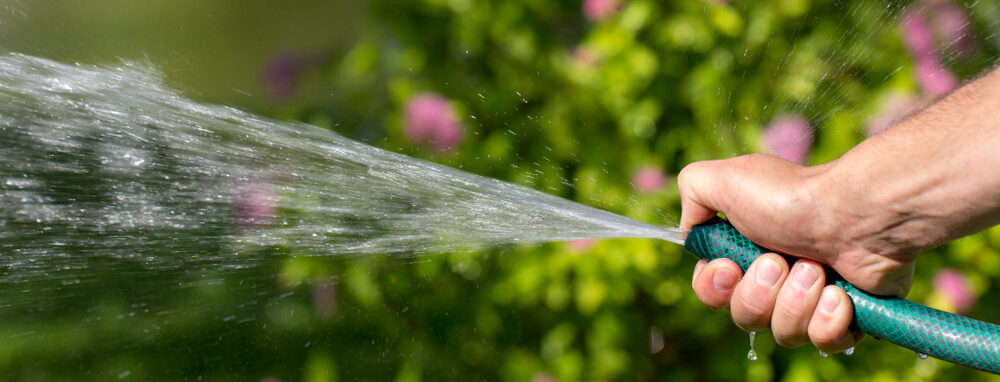
Mastering Garden Watering: Tips & Techniques
We all know that we need to water our gardens. But how much is too much? And how do you save water for an all-round greener garden?
🌱 All important maintenance moments for your lawn during the year. Leave your email and we will send you the lawn calendar for free.
Enter your email
Receive the lawn calendar in the mail
Enjoy a green lawn all year round!

- Order by 2PM = shipped today
- 250.000+ satisfied customers!
- 60 day satisfaction guarantee
We all know that we need to water our gardens. But how much is too much? And how much is too little?
- Why do we need to water our garden?
- What is the best time of day to water your plants?
- How often do I need to water my plants?
- How do you know when to water your plants?
- How much water does my garden need?
- For how long should you water your garden?
- How to water your plants
- Watering your garden with different soil types
- Our Top Watering Tips!
- FAQs
When is the best time to water? How much water do your plants need? And how often should you water your lawn? It’s all questions, questions, questions, isn’t it!
Luckily, this article provides the answers to everything you’ll ever need to know about watering your plants. And if you still have a burning question at the end, just get in touch, and we’ll be happy to help.
Ready? Let’s get watering!
Why do we need to water our garden?
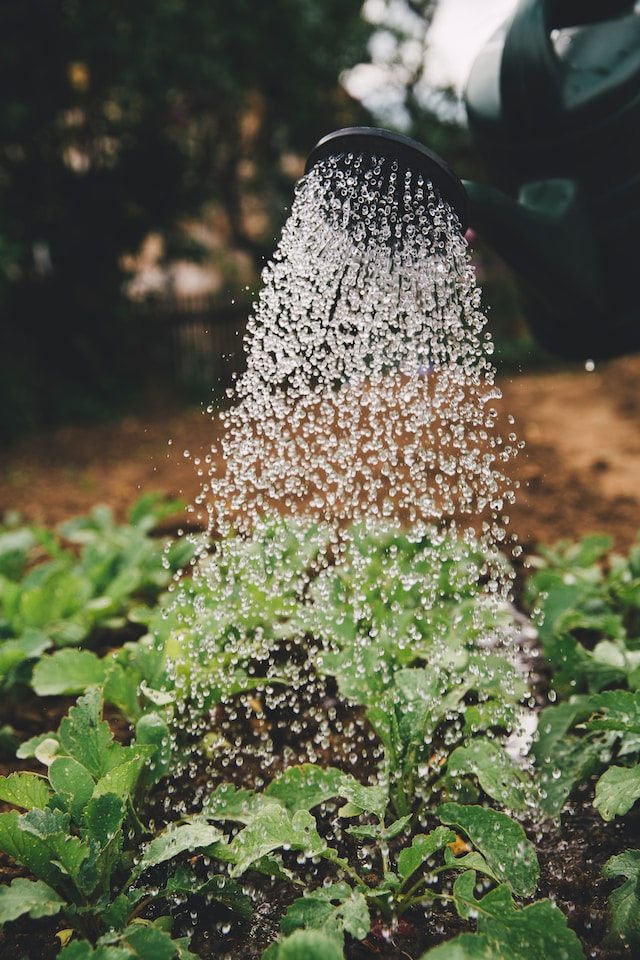
Watering ensures your plants remain healthy, vibrant, and productive. Just as we humans need water to stay hydrated and function effectively, plants also need water to facilitate their growth and development. Watering your plants supports effective photosynthesis, a process in which plants convert sunlight into food.
Additionally, watering your garden helps maintain the soil’s fertility by dissolving nutrients and minerals into the earth, which are then absorbed by your plants’ roots.
So, whether you are growing roses, rhododendrons, ryegrass, or radishes, remember that your garden requires consistent watering to thrive.
What is the best time of day to water your plants?
Early morning is the best time of day to water your plants. This allows the water to penetrate your plants’ roots, preparing them for the day’s heat. So, make sure you water early during the summer.
However, if you can’t water first thing in the morning, water in late afternoon or early evening when temperatures are cooler.
However, don’t leave your plants wet overnight, particularly when the evenings are cool or cold, as this increases the risk of fungal diseases.
In extremely hot and dry weather, it might be necessary to water both in the morning and the evening to ensure your plants stay hydrated. Understanding the specific watering needs of your plants is crucial to their health and growth.
How often do I need to water my plants?
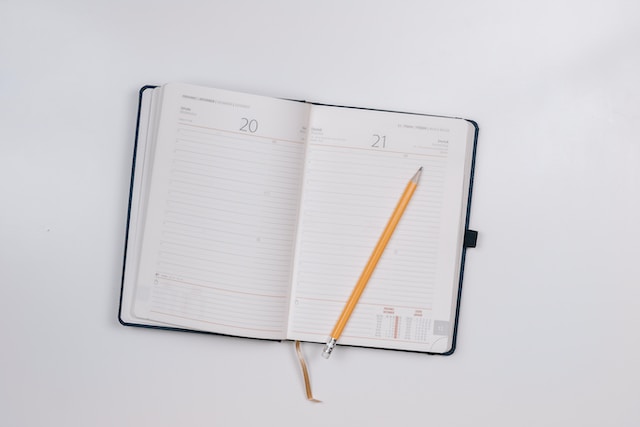
The watering frequency largely depends on the type of plant, the climate, the soil type, and the season.
The best way to ascertain whether to water a is to press your finger into the top inch of soil; it needs water if it feels dry.
However, overwatering is just as harmful as underwatering – it’s likely to cause root rot and other diseases. Therefore, understanding each plant’s unique watering needs is vital for its overall health.
Remember, some plants prefer dry soil, such as:
- Sedums
- Iris
- Foxtail lilies
- Lavender
- Cardoon
- Thistles, such as Teasels (Dipsacus)
- Passionflower
How do you know when to water your plants?
The most obvious signs that your plant needs water are dry, wilting, or brittle leaves.
However:
Overwatering can also cause wilting, so it’s crucial to understand the difference. Indeed, an underwatered plant will look limp and dehydrated, while an overwatered plant may have yellow leaves and a sickly appearance.
Check the soil
Another way to determine if your plant needs water is to check the soil.
Dry soil is often lighter in colour with a cracked surface, with edges pulling away from the sides of the pot.
A simple touch test can also indicate soil dryness: as mentioned, if you stick your finger about an inch into the soil and it’s dry, then it’s time to water your plant.
Or buy a moisture meter, which precisely measures the soil’s moisture levels.
For more details about soil conditions, check out our article: How To Improve Your Lawn in a Shaded Garden.
How much water does my garden need?
On average, most gardens require about 1 inch of water per week, including rainfall. This rule of thumb provides a good starting point, but remember that certain plants may need more or less water.
For instance, succulents and cacti need less water than ferns and other moisture-loving plants.
Sandy or clay soil?
Consider your garden’s soil type. Sandy soils don’t hold water well and need more frequent watering, while clay soils retain water and require less regular watering.
Remember, watering deeply and less frequently is better, as it encourages deeper root systems, making them more drought-tolerant.
For how long should you water your garden?
Firstly, bear in mind how much rainfall you’re getting before watering because you can easily overwater your garden plants and lawn.
As mentioned, your garden requires around 1 inch of water a week, so measure the amount of rainfall you get with a rain gauge.
If you get less than 1 inch of rainfall, supplement it with your garden sprinkle.
If supplementing rainfall with a sprinkler system, measure the water you add using the rain gauge. And stop watering when you’ve reached 1 inch of water.
This will show you how long you need to water to reach that 1-inch mark.
How to water your plants
Of course, there are several ways to water your garden plants. Here are some top tips:
Watering with a watering can
Always water at the base of the plant to direct moisture to the roots, where it’s most needed.
- Start with a gentle stream from the watering can to prevent soil erosion or damage to tender plants.
- Monitor the water level as you pour, ensuring it doesn’t pool on the soil surface, which could indicate overwatering.
- Remember, it’s better to water your plants thoroughly and less frequently, as this encourages deep root growth and improves plant resilience.
Watering with a garden hose by hand
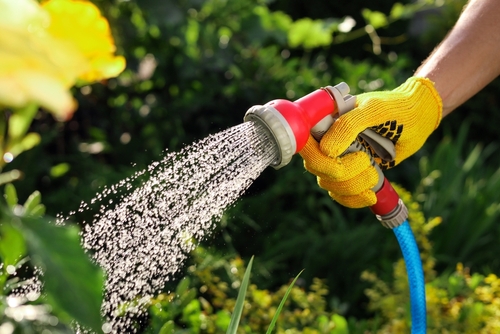
This traditional method hydrates your plants and allows you to closely observe them, making it easier to spot any issues, such as pests or diseases.
When using a garden hose:
- Keep the water pressure low to avoid eroding the soil or damaging your plants.
- Consider using a spray nozzle for better control and to evenly distribute water.
- Just like watering with a can, aim for the base of the plant to ensure the water reaches the roots effectively.
- Remember , overwatering is as harmful as underwatering, and it’s easy to overwater with a hose. Avoid pooling water on the soil surface.
Watering with self-watering containers
Self-watering containers offer a convenient and efficient watering solution, particularly for busy gardeners.
These containers have a built-in reservoir, which drip feeds your plants through a wicking system, drawing water to the roots as needed.
This method is beneficial for plants that prefer consistently moist soil. However, monitoring the reservoir level is vital to ensure it doesn’t become completely dry or overly saturated.
So, fill the reservoir once a week to encourage deeper root growth, promoting overall plant health.
Watering with a garden sprinkler
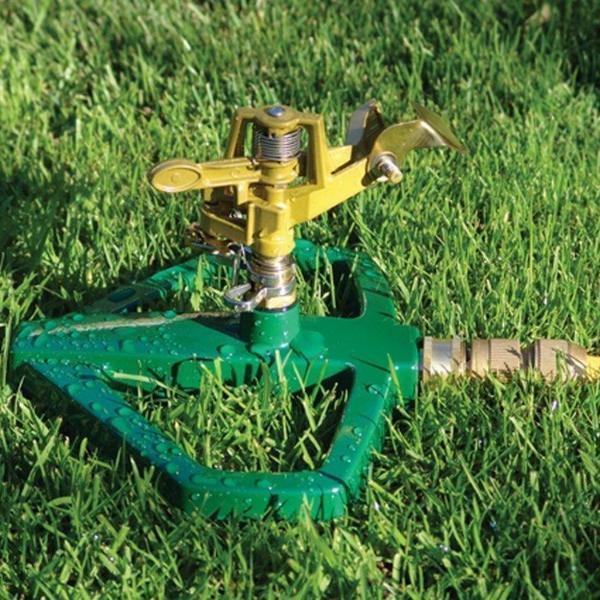
Watering with a garden sprinkler efficiently hydrates your plants, especially for larger gardens or lawns.
Sprinklers distribute water evenly over a wide area, ensuring all plants receive adequate hydration.
The best time to use a sprinkler is in the early morning or late afternoon when the sun’s heat won’t cause rapid evaporation. However, monitoring the amount of water your garden receives is crucial, as sprinklers can sometimes overwater plants.
Also, be mindful that not all plants are suited for sprinkler watering; some, like succulents or cacti, prefer dryer conditions, and direct watering could lead to root rot.
Lastly, adjust your watering schedule based on rainfall to prevent overwatering.
Watering your garden with automatic sprinkler systems
Automatic sprinkler systems are a highly efficient method for watering your garden because they water your plants at specific times, ensuring consistent moisture levels and minimizing the risk of over or under-watering.
They distribute water evenly across the garden, promoting uniform growth and significantly reducing manual labour — particularly beneficial for extensive gardens.
However, adjust the system based on plant types and weather conditions to avoid excessive watering.
Watering with a drip hose
Watering with a drip hose, also known as a soaker hose, promotes efficient water use by slowly releasing water directly into the soil. This ensures the water reaches your plants’ roots rather than evaporating or running off the surface.
This helps reduce water waste and is ideal for watering rows of plants or extensive garden beds.
Furthermore, a drip hose minimizes the disease risk by keeping water off the plant’s leaves, which can be a breeding ground for fungi and other pathogens.
Watering your garden with different soil types
Not all garden soils are the same; some hold onto water more willingly than others. So, check whether you have sandy or clay soil by taking a handful of garden earth and squeezing it into the palm of your hand.
Open your palm — if the soil crumbles and falls apart, you have sandy soil; if it sticks together, you have clay soil.
How to water clay soil
Watering clay soil requires a careful and thoughtful approach as it tends to hold water longer and can quickly become waterlogged.
So, instead of watering frequently, water deeply and infrequently. This allows the soil to dry out more in between waters.
This encourages profound root growth and prevents overwatering. Pour water slowly and evenly, giving it ample time to be absorbed and preventing runoff.
Use a moisture meter to check the soil’s moisture levels before watering again.
How to water sandy soil
Watering sandy soil requires a tailored approach due to its unique characteristics.
Sandy soil absorbs and loses water quickly, necessitating quick and short watering periods. The main objective is to thoroughly wet the root zone without over-saturating it.
Ideally, water every other day during dry weather.
To make sandy soil more moisture-retentive, consider improving its structure by adding organic matter such as compost or grass clippings. Adopting these strategies will help ensure that plants in sandy soil receive adequate hydration without overwatering, promoting their healthy growth.
Our Top Watering Tips!
These are our favourite watering tips!
Watering tip 1: Develop a sprinkling strategy
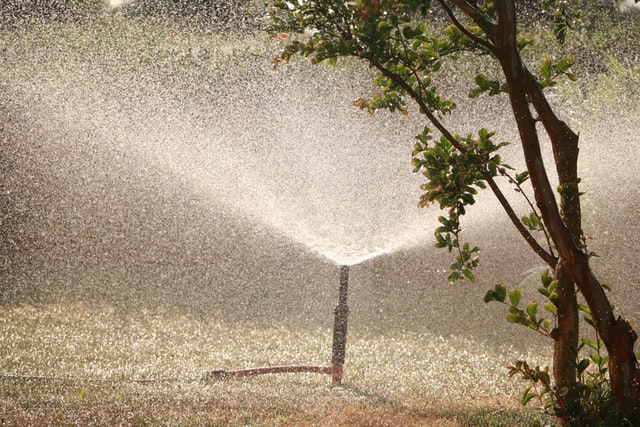
You can water your garden by hand, of course. It can be calming and satisfying to sprinkle water using a can, but it’s also time-consuming if you have a large garden. And if you’re watering your lawn, it takes forever with a can.
But before you just set your sprinkler to sprinkle every day, there are some things to consider.
Consider gardens in the wild
In the wild, very few British plants can expect water every day. Sure, we all moan about the British weather and complain that it rains too much – but, on average, it rains 1-in-3 days in the UK.
If you water your plants every day, their root systems become lazy. Plants are only as healthy as their roots – overwatering encourages roots to spread little and remain shallow in the soil. We want our roots deep into the ground, helping the plant develop greater drought resistance, while absorbing the nutrients to be found in the deeper earth.
So, develop a watering strategy.
How to water your lawn
Check the weather forecast and make sure there’s no rain ahead.
Water once or twice a week – about 2.5 cm of water, causing the water to penetrate more deeply into the soil. This will make the roots search deeper for water.
Deeper roots keep your lawn greener for longer, even during drought and when hose pipes are banned!
Watering tip 2: Save rainwater
We might think that running the tap is free, but you’ll quickly discover how expensive it can be to water your plants if you’re on a water meter.
Rainwater, on the other hand, IS free and usually in reasonably plentiful supply in the UK.
Rainwater is rich in minerals and doesn’t contain lime (like tap water), making the water quality soft and perfect for your plants. Additionally, the temperature of rainwater is less likely to shock your plants (it’s more likely to be closer to the air temperature).
Watering tip 3: Collect water in a water butt
We tend to think of drought as the product of a long, hot summer, but drought can occur at any time of year. A drought is a period of unusually low rainfall, but it can also be caused by heavy demand for water supplies.
So, wherever possible, it’s always best to collect rainfall in a water butt. There’s a range of styles and sizes of rainwater harvesting systems, but the simplest are really affordable.
Just think of the savings against your water bill.
Simply attach your water butt to a downspout from your roof guttering, and it will collect rainfall for later use. Keep a lid on the butt to keep the water clean.
Find out everything you need to know about collecting rainwater here.
Watering tip 4: Design your garden smartly
Believe it or not, but the placement of your plants affects how much you need to water them. You can save water by considering how much direct sunlight your garden receives.
Most gardens have sunny spots as well as shaded areas covered by overhanging trees or walls. Some plants are more naturally drought-tolerant than others – arrange your plants by the amount of water they need. Shrubs and bushes tend to be more drought-tolerant than smaller, single-stemmed plants.
So:
Place your drought-tolerant plants in the areas that get the most sunlight and your more thirsty plants in the less sunny spots.
Of course, most plants need lots of sun to thrive, so always read the plant’s label when you buy it from a garden centre (or the seed packet if you’re growing from seed)..
Watering tip 5: Mulch – covering your soil
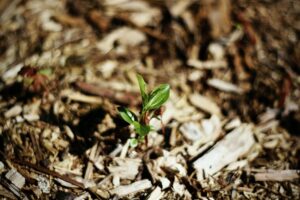
Mulching helps save water by minimising evaporation and suppressing moisture-stealing weeds. Mulch also improves the appearance of the soil around your plants.
A good layer of well-rotted mulch helps warm up the earth in the spring, retain moisture during the summer, and encourage greater water penetration in the winter.
You can cover your ground with biodegradable mulch, such as garden compost, leaf mould, well-rotted manure, straw, or wood chippings. These organic mulches contribute nutrients to the soil, but they’ll need regular topping up.
Non-biodegradable soil coverings such as slate, pebbles, gravel, or stone chippings can be a better longer-term mulch, but they don’t break down and provide nutrients. Any dark-coloured mulch will warm the soil up in the sun, whereas lighter-coloured mulch keeps the ground cool.
Alternatively, you can choose a sheet (or woven) mulch for longer-term coverage.
Watering tip 6: Use a Drip
A soaker (or drip) hose is a porous hosepipe, designed to leak. It ensures that whatever water you provide gets to the plant’s roots.
One of the problems with watering from a can (or a traditional hosepipe) is that the water doesn’t always penetrate deeply into the soil before the sun evaporates it. And some plants (like courgettes) dislike getting their leaves wet, so a soaker hose is an ideal solution and uses 70% less water than traditional watering, providing continuous watering at a slow dripping rate.
Connect your soaker hose to the garden tap or your water butt.
Keep the water pressure low (use a regulator if you’re unsure).
Make sure the water butt is suitably elevated so that there’s enough water pressure!
A drip hose prevents overwatering and makes excellent use of your water butt.
Watering tip 7: Prevent Legionella
Always drain residual water from your garden hose, especially during the summer months.
If you leave your garden hose in full sun, the water that sits in the pipe heats up, creating the perfect environment for the Legionella bacteria to develop.
You probably know that Legionella (more commonly known as Legionnaires Disease) is a potentially life-threatening respiratory condition – effectively a severe form of pneumonia. If the water sitting in your hose is contaminated, you can inhale some of that bacteria while you spray.
Err on the side of caution: rinse your hose before use.
Remove the nozzle and hang the end into a bucket filled with water.
Leave the tap running for a couple of minutes with the end of the hose submerged in the bucket to prevent spray.
Watering tip 8: drain your garden hose
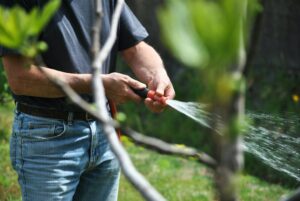
You probably don’t use your hose during the winter months (unless you’re washing the car), so ensure that you drain it thoroughly before putting it away for the winter.
Any water that remains in the hose can freeze when the temperatures plummet.
We’ve probably all left a bottle of wine in the freezer before (or is that just me?). If you forget about it and the wine freezes completely, the liquid expands as it freezes and breaks the bottle. This can happen with your hosepipe.
So, drain your hose entirely so that you’re not rushing off to the DIY store in the spring.
FAQs
Generally, water your garden once or twice a week. Give the soil a deep soaking to encourage roots to grow deeply. During hot, dry spells, water more frequently. Always check the soil’s moisture level before watering to avoid over or under-watering. Remember, less frequent, deep watering is better than frequent, shallow watering.
The best time to water your garden is early morning before the heat of the day sets in. This reduces water loss through evaporation. If morning watering isn’t possible, late afternoon is another good time, but ensure plants have time to dry before nightfall to prevent disease.
In the summer, your garden may need daily watering due to higher temperatures and increased evaporation. However, this depends on your plant’s needs and the soil type. Overwatering can lead to root rot and other diseases. It’s best to check the soil’s moisture levels before watering.
Any questions?
I hope I’ve answered everything you’ll ever need to know about watering your garden! But if you have any questions, get in touch.
Alternatively, check out our comprehensive Help & Advice section for all your gardening and lawn care know how.
Do you have more water tips? Leave them in the comments.
Thanks for reading.
Happy watering, everyone.
-
How to Build a DIY Greenhouse: A Practical Guide for Smart SpendersImagine extending your growing season throughout the year, nurturing tender plants regardless of the weather, and creating a personal garden sanctuary. This is precisely what a DIY greenhouse offers you. Let’s learn how to build one.Read more
-
How to Grow Eucalyptus in British GardensWith a little love and care, eucalyptus trees can thrive in English gardens. Since they don’t germinate well without proper help, there are not considered invasive. So, there is no reason not to plant them if you enjoy their looks.Read more
-
Transform Your Garden with All-Year-Round Flowering PlantsDid you know you can enjoy blooming flowers even in January? With the right selection of all year round plants, there’s no need to wait until spring to add some colour to your garden.Read more
-
How to Create a Butterfly Garden: A Simple Guide for British GardensThe UK's butterfly population includes 59 different species. These beautiful winged creatures face a steady decline because of habitat loss, pollution and changing weather patterns. Your garden can become a vital link between nature reserves and natural habitats. Let’s explore how.Read more
-
Volcanic Rock Dust for Your Garden—Application and TipsDid you know that volcanic rock dust is a brilliant organic soil improver? This article explains exactly what it's good for and how to use it properly.Read more
-
How to Use Landscape Fabric ProperlyIf weeds or erosion in your garden are troubling you, landscape fabric might be the solution. We’ll explain how and when to use it properly, just keep on reading.Read more
-
Hostas: A Complete Care GuideIf you have a north-facing garden or some shady corners on your property, hostas are the plants for you. These green delights thrive particularly well in partial to full shade and require consistently moist soil to perform at their best.Read more
-
How to Grow Grapes in Your Garden: A Simple Step-by-Step GuideGrapevines produce some tasty fruits, but often they are simply grown for their gorgeous leaves. Whatever your motivation may be, we have a guide on how to grow grapes for you.Read more
Leave a comment
Your answer will be displayed on the site and the interested party will be notified by email.
Leave a comment
Have a question or want to share your experience? Leave us a comment.

- Order by 2PM = shipped today
- 250.000+ satisfied customers!
- 60 day satisfaction guarantee

- Order by 2PM = shipped today
- 250.000+ satisfied customers!
- 60 day satisfaction guarantee

- Order by 2PM = shipped today
- 250.000+ satisfied customers!
- 60 day satisfaction guarantee

🌱 All important maintenance moments for your lawn during the year. Leave your email and we will send you the lawn calendar for free.
Enter your email
Receive the lawn calendar in the mail
Enjoy a green lawn all year round!



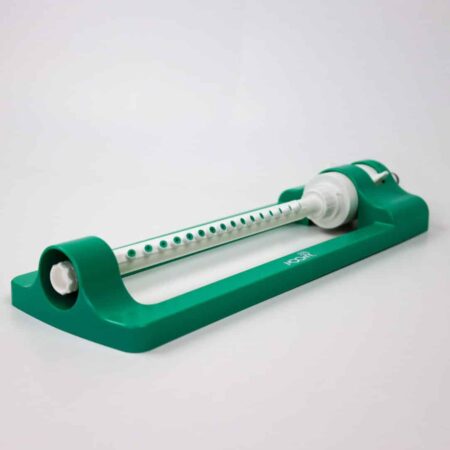
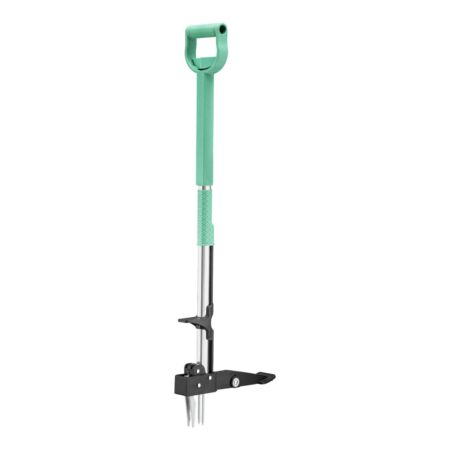
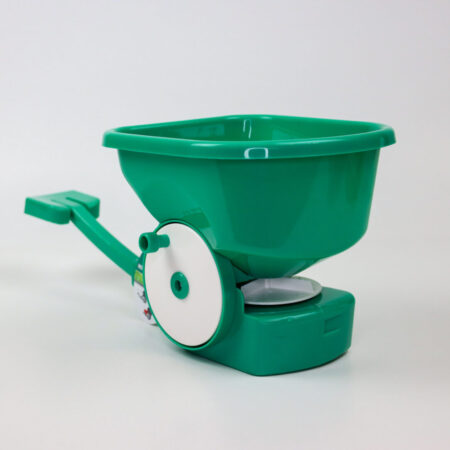


















Comments (0)
There are no comments yet. Well then, what are you waiting for to
Be the first to write your comment!inaugurate this pretty page?
Do you have some comments?